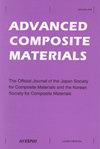Fully analytical solution framework for general thin-walled composite beams with mixed variational approach
IF 2.3
3区 材料科学
Q3 MATERIALS SCIENCE, COMPOSITES
引用次数: 0
Abstract
AbstractA variationally consistent analytical beam model that describes the theory in a Timoshenko-Vlasov level is developed based on Reissner’s mixed variational theorem. Starting from a shell theory, all the field-governing equations (equilibrium and continuity) and the boundary conditions of the shell wall are derived in closed form, and the mixed method enables finding the explicit forms of the reactive stresses and sectional warpings which are evaluated progressively depending on the level of beam model to be analyzed. The stress recovery part is incorporated in the post-stage of the analysis to compute the layer-wise distribution of stresses over the beam cross-section. The present analysis is validated against numerous benchmark examples available in the literature, including beams with multi-layered strip section, thin-walled anisotropic box sections with elastic couplings, and two-cell airfoil section. The comparison study demonstrates excellent correlations with the results from detailed three-dimensional finite element analysis and other up-to-date beam approaches. Also presented are symbolically expressed stiffness coefficients and the sectional warping modes of coupled composite beams to demonstrate the strength of the proposed beam model.Keywords: Beamsection analysiswarpingstress recovery; stiffness matrix Nomenclature a=Local shell radius of curvatureFx=Axial force along x axisFy, Fz=Shear forces along y and z axesMx=Torsional moment about x axisMy, Mz=Bending moments about y and z axesMω=Torsional bi-momentMxx, Mss, Mxs=Bending and twisting couples of the shell wallNxx, Nss, Nxs=In-plane stress resultants of the shell wallNxn, Nsn=Transverse shear stress resultants of the shell wallU, V, W=Translational displacements of beam sectional reference origin along x, y, z axesu, v, w=Translational displacements of an arbitrary material point of beam section along x, y, z axesux, us, un=Translational displacements of the shell wall along x, s, n axesβy, βz=Sectional rotation angles about y and z axesγxn,γsn=Transverse shear strains of the shell wallγxn,γsn=Transverse shear strains of the beam in x-y, x-z planesγxs=In-plane shear strain of the shell wall\isinxx,\isinss=In-plane normal strains of the shell wallκxx,κss,κxs=Curvatures of the shell wallϕ=Sectional rotation angle about x axisψx, ψs=Rotation angles of the shell wall about s, x axesωx=Contour warping function along x axisSubscripts=(),x, (),s=∂()/∂x, ∂()/∂sSuperscripts=()T=Transpose of an array()−1=Inversion of an arrayDisclosure statementThe authors declare that they have no known competing financial interests or personal relationships that could have appeared to influence the work reported in this paper.Additional informationFundingThis work was supported by the National Research Foundation of Korea (NRF) grant funded by the Korea government (MSIT) (No. 2022R14A1018884). This work was supported by Korea Research Institute for defense Technology planning and advancement (KRIT) grant funded by the Korea government (DAPA (Defense Acquisition Program Administration) (21-107-E00-007, 2023)). This paper was written as part of Konkuk University’s research support program for its faculty on sabbatical leave in 2022.一般薄壁组合梁的混合变分全解析解框架
摘要基于Reissner的混合变分定理,建立了一个在Timoshenko-Vlasov水平上描述理论的变分一致解析梁模型。该方法从壳层理论出发,以封闭形式导出了所有的场控制方程(平衡方程和连续方程)以及壳壁的边界条件,并根据待分析梁模型的水平逐步求出了响应应力和截面挠曲的显式形式。应力恢复部分被纳入分析的后期阶段,以计算应力在梁截面上的分层分布。目前的分析是验证了许多基准的例子,可在文献中,包括梁与多层条形截面,薄壁各向异性箱体截面与弹性联轴器,和双单元翼型截面。对比研究表明,详细的三维有限元分析和其他最新的梁方法的结果具有良好的相关性。文中还给出了组合梁的刚度系数和截面翘曲模态的符号表示,以说明所提出的组合梁模型的强度。关键词:梁截面分析;翘曲;应力恢复;名称a=局部壳曲率半径refx =沿x轴的轴向力fy, Fz=沿y轴和z轴的剪力mx =沿x轴的扭转力矩my, Mz=沿y轴和z轴的弯矩m ω=扭转双力矩mxx, Mss, Mxs=沿y轴和z轴的弯矩nxx, Nss, Nxs=沿壳壁的弯扭耦合nxx, Nss, Nxs=壳壁的面内应力值nxn, Nsn=沿壳壁的横向剪切应力u, V, W=梁截面参考原点沿x、y、z轴的平移位移u, V, W=梁截面参考原点沿x、y、z轴的平移位移u, V, V,w=梁截面任意质点沿x、y、z轴的平移位移;ux、us、un=壳壁沿x、s、n轴的平移位移;βy、βz=沿y、z轴的截面旋转角γxn、γsn=壳壁的横向剪切应变γxn、γsn=梁在x-y方向的横向剪切应变;x-z平面γxs=壳壁的面内剪切应变\isinxx,\isinss=壳壁的面内法向应变κxx,κss,κxs=壳壁的曲率φ =关于x轴的截面旋转角,ψs=关于s, x轴的壳壁旋转角ωx=沿x轴的轮廓弯曲函数subscripts =(),x, (),s=∂()/∂x,∂()/∂sSuperscripts=()T=数组的转置()−1=数组的反转披露声明作者声明他们没有已知的竞争经济利益或个人关系,这些利益或关系可能会影响本文所报告的工作。本研究由韩国政府(MSIT)资助的韩国国家研究基金会(NRF)资助(No. 2022R14A1018884)。这项工作由韩国政府(DAPA(国防采办计划管理局)(21-107-E00-007, 2023))资助的韩国国防技术规划与进步研究所(KRIT)资助。这篇论文是建国大学2022年休假教师研究支援计划的一部分。
本文章由计算机程序翻译,如有差异,请以英文原文为准。
求助全文
约1分钟内获得全文
求助全文
来源期刊

Advanced Composite Materials
工程技术-材料科学:复合
CiteScore
5.00
自引率
20.70%
发文量
54
审稿时长
3 months
期刊介绍:
"Advanced Composite Materials (ACM), a bi-monthly publication of the Japan Society for Composite Materials and the Korean Society for Composite Materials, provides an international forum for researchers, manufacturers and designers who are working in the field of composite materials and their structures. Issues contain articles on all aspects of current scientific and technological progress in this interdisciplinary field. The topics of interest are physical, chemical, mechanical and other properties of advanced composites as well as their constituent materials; experimental and theoretical studies relating microscopic to macroscopic behavior; testing and evaluation with emphasis on environmental effects and reliability; novel techniques of fabricating various types of composites and of forming structural components utilizing these materials; design and analysis for specific applications.
Advanced Composite Materials publishes refereed original research papers, review papers, technical papers and short notes as well as some translated papers originally published in the Journal of the Japan Society for Composite Materials. Issues also contain news items such as information on new materials and their processing."
 求助内容:
求助内容: 应助结果提醒方式:
应助结果提醒方式:


